Strategic Development of BHP Billiton: Management Report
VerifiedAdded on 2023/06/06
|17
|3385
|350
Report
AI Summary
This report provides an in-depth analysis of BHP Billiton's strategic development, focusing on its management strategies within the business environment. The report examines strategy deployment, including mission, vision, and core competencies, as well as past and current successful strategies. It critically assesses these strategies, exploring associated criticisms and limitations. Furthermore, the report conducts an environmental analysis using Porter's Five Forces and SWOT analysis to understand the external and internal factors influencing the company. It also delves into BHP Billiton's organizational culture, core values, and identifies notable leaders. The report concludes with a summary of findings and insights into BHP Billiton's strategic approach.
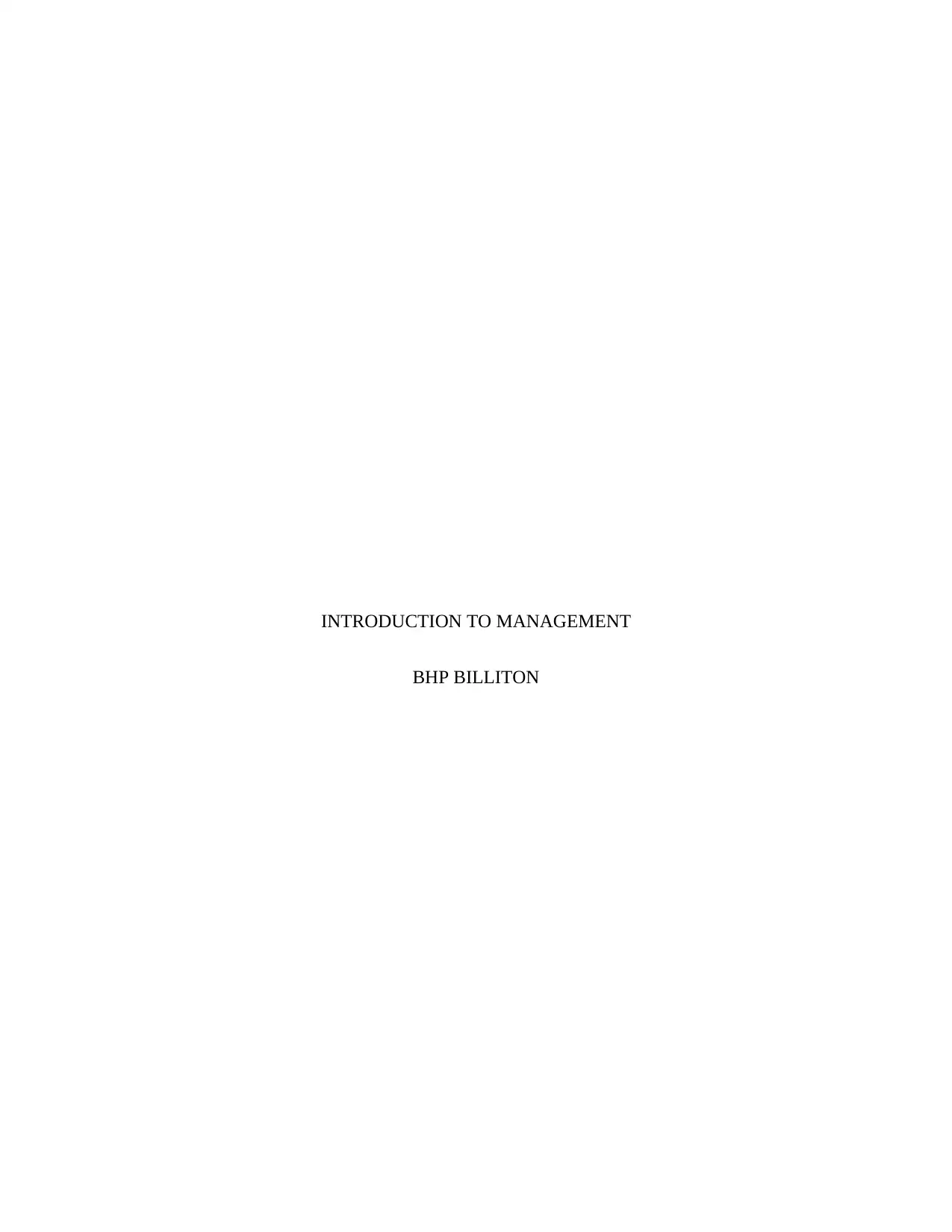
INTRODUCTION TO MANAGEMENT
BHP BILLITON
BHP BILLITON
Paraphrase This Document
Need a fresh take? Get an instant paraphrase of this document with our AI Paraphraser
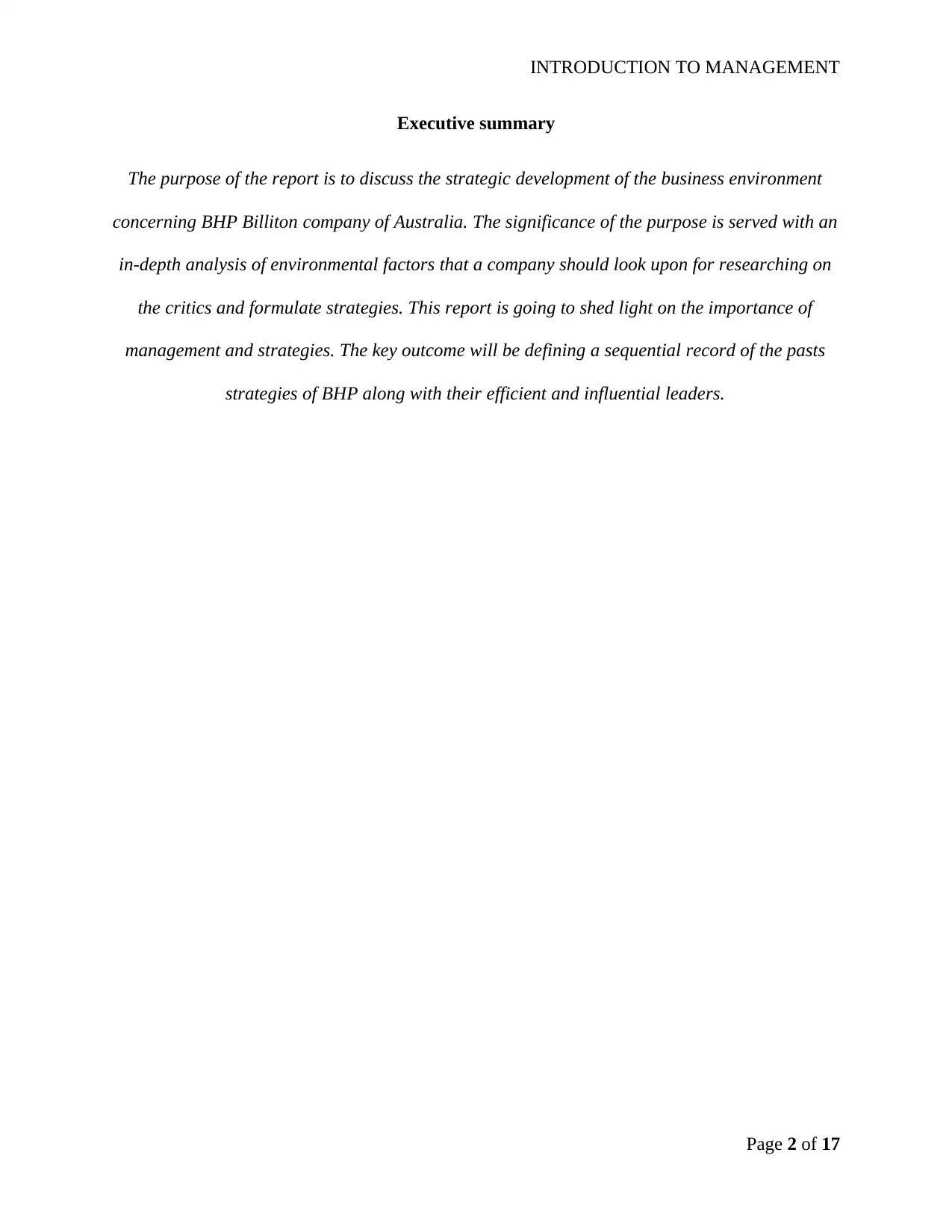
INTRODUCTION TO MANAGEMENT
Executive summary
The purpose of the report is to discuss the strategic development of the business environment
concerning BHP Billiton company of Australia. The significance of the purpose is served with an
in-depth analysis of environmental factors that a company should look upon for researching on
the critics and formulate strategies. This report is going to shed light on the importance of
management and strategies. The key outcome will be defining a sequential record of the pasts
strategies of BHP along with their efficient and influential leaders.
Page 2 of 17
Executive summary
The purpose of the report is to discuss the strategic development of the business environment
concerning BHP Billiton company of Australia. The significance of the purpose is served with an
in-depth analysis of environmental factors that a company should look upon for researching on
the critics and formulate strategies. This report is going to shed light on the importance of
management and strategies. The key outcome will be defining a sequential record of the pasts
strategies of BHP along with their efficient and influential leaders.
Page 2 of 17
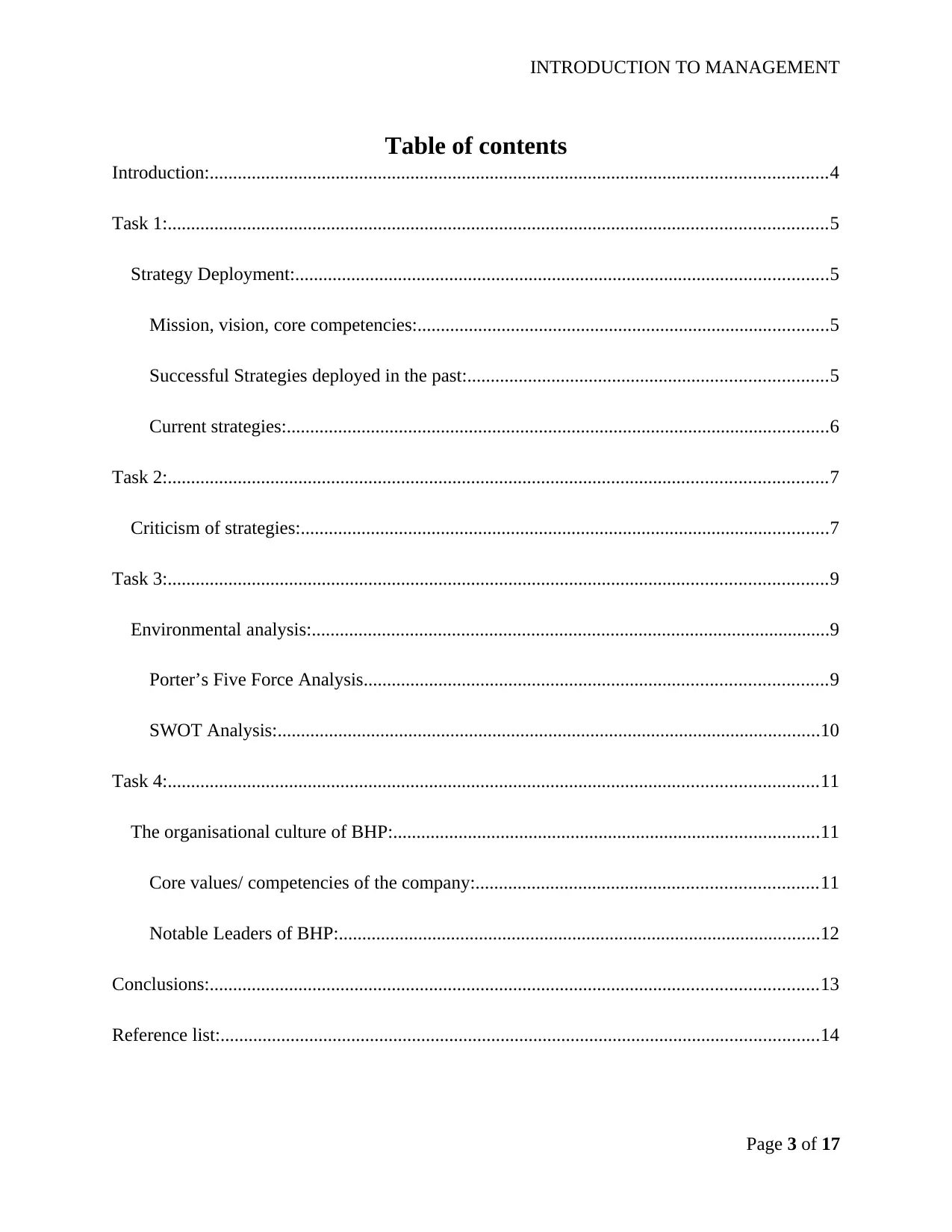
INTRODUCTION TO MANAGEMENT
Table of contents
Introduction:....................................................................................................................................4
Task 1:.............................................................................................................................................5
Strategy Deployment:..................................................................................................................5
Mission, vision, core competencies:........................................................................................5
Successful Strategies deployed in the past:.............................................................................5
Current strategies:....................................................................................................................6
Task 2:.............................................................................................................................................7
Criticism of strategies:.................................................................................................................7
Task 3:.............................................................................................................................................9
Environmental analysis:...............................................................................................................9
Porter’s Five Force Analysis...................................................................................................9
SWOT Analysis:....................................................................................................................10
Task 4:...........................................................................................................................................11
The organisational culture of BHP:...........................................................................................11
Core values/ competencies of the company:.........................................................................11
Notable Leaders of BHP:.......................................................................................................12
Conclusions:..................................................................................................................................13
Reference list:................................................................................................................................14
Page 3 of 17
Table of contents
Introduction:....................................................................................................................................4
Task 1:.............................................................................................................................................5
Strategy Deployment:..................................................................................................................5
Mission, vision, core competencies:........................................................................................5
Successful Strategies deployed in the past:.............................................................................5
Current strategies:....................................................................................................................6
Task 2:.............................................................................................................................................7
Criticism of strategies:.................................................................................................................7
Task 3:.............................................................................................................................................9
Environmental analysis:...............................................................................................................9
Porter’s Five Force Analysis...................................................................................................9
SWOT Analysis:....................................................................................................................10
Task 4:...........................................................................................................................................11
The organisational culture of BHP:...........................................................................................11
Core values/ competencies of the company:.........................................................................11
Notable Leaders of BHP:.......................................................................................................12
Conclusions:..................................................................................................................................13
Reference list:................................................................................................................................14
Page 3 of 17
⊘ This is a preview!⊘
Do you want full access?
Subscribe today to unlock all pages.

Trusted by 1+ million students worldwide
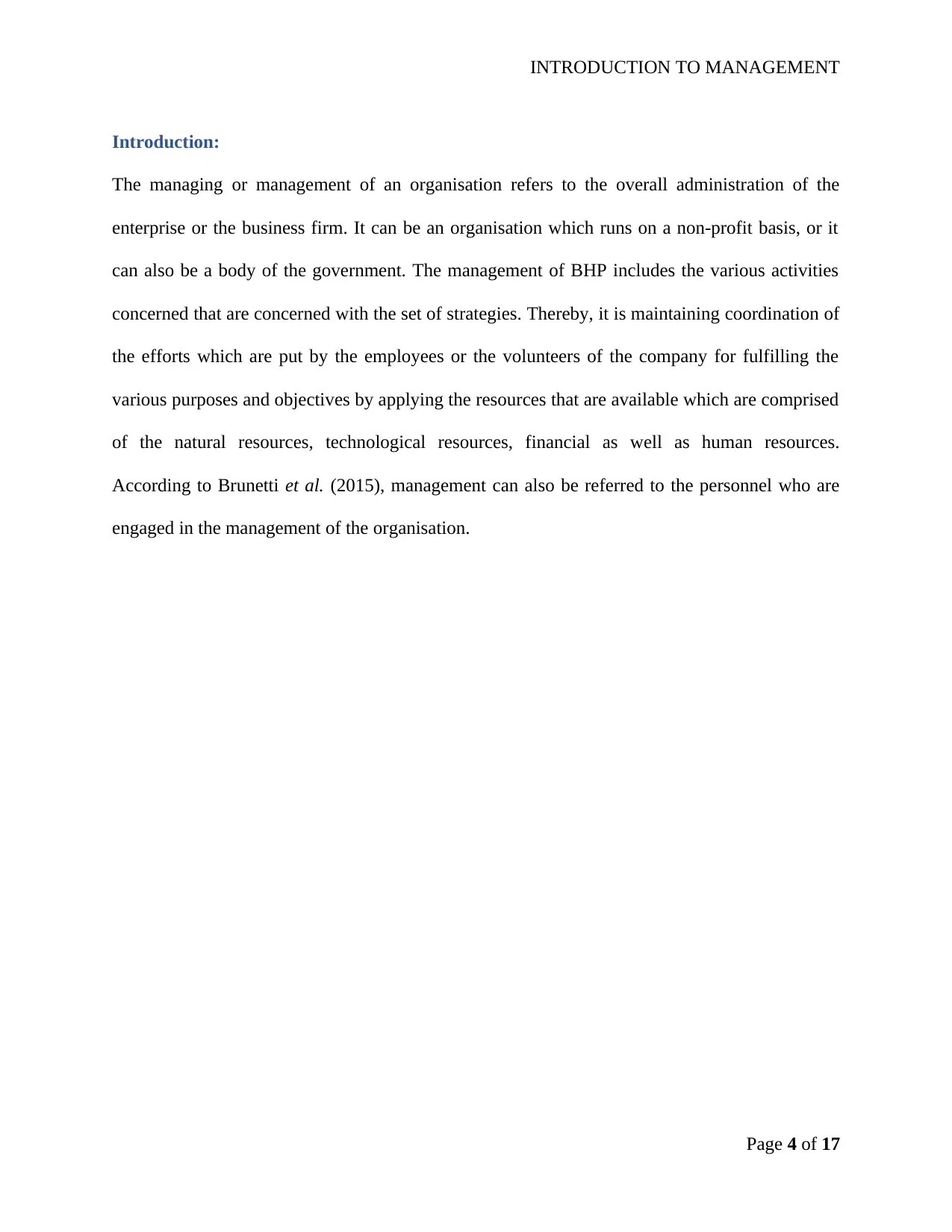
INTRODUCTION TO MANAGEMENT
Introduction:
The managing or management of an organisation refers to the overall administration of the
enterprise or the business firm. It can be an organisation which runs on a non-profit basis, or it
can also be a body of the government. The management of BHP includes the various activities
concerned that are concerned with the set of strategies. Thereby, it is maintaining coordination of
the efforts which are put by the employees or the volunteers of the company for fulfilling the
various purposes and objectives by applying the resources that are available which are comprised
of the natural resources, technological resources, financial as well as human resources.
According to Brunetti et al. (2015), management can also be referred to the personnel who are
engaged in the management of the organisation.
Page 4 of 17
Introduction:
The managing or management of an organisation refers to the overall administration of the
enterprise or the business firm. It can be an organisation which runs on a non-profit basis, or it
can also be a body of the government. The management of BHP includes the various activities
concerned that are concerned with the set of strategies. Thereby, it is maintaining coordination of
the efforts which are put by the employees or the volunteers of the company for fulfilling the
various purposes and objectives by applying the resources that are available which are comprised
of the natural resources, technological resources, financial as well as human resources.
According to Brunetti et al. (2015), management can also be referred to the personnel who are
engaged in the management of the organisation.
Page 4 of 17
Paraphrase This Document
Need a fresh take? Get an instant paraphrase of this document with our AI Paraphraser
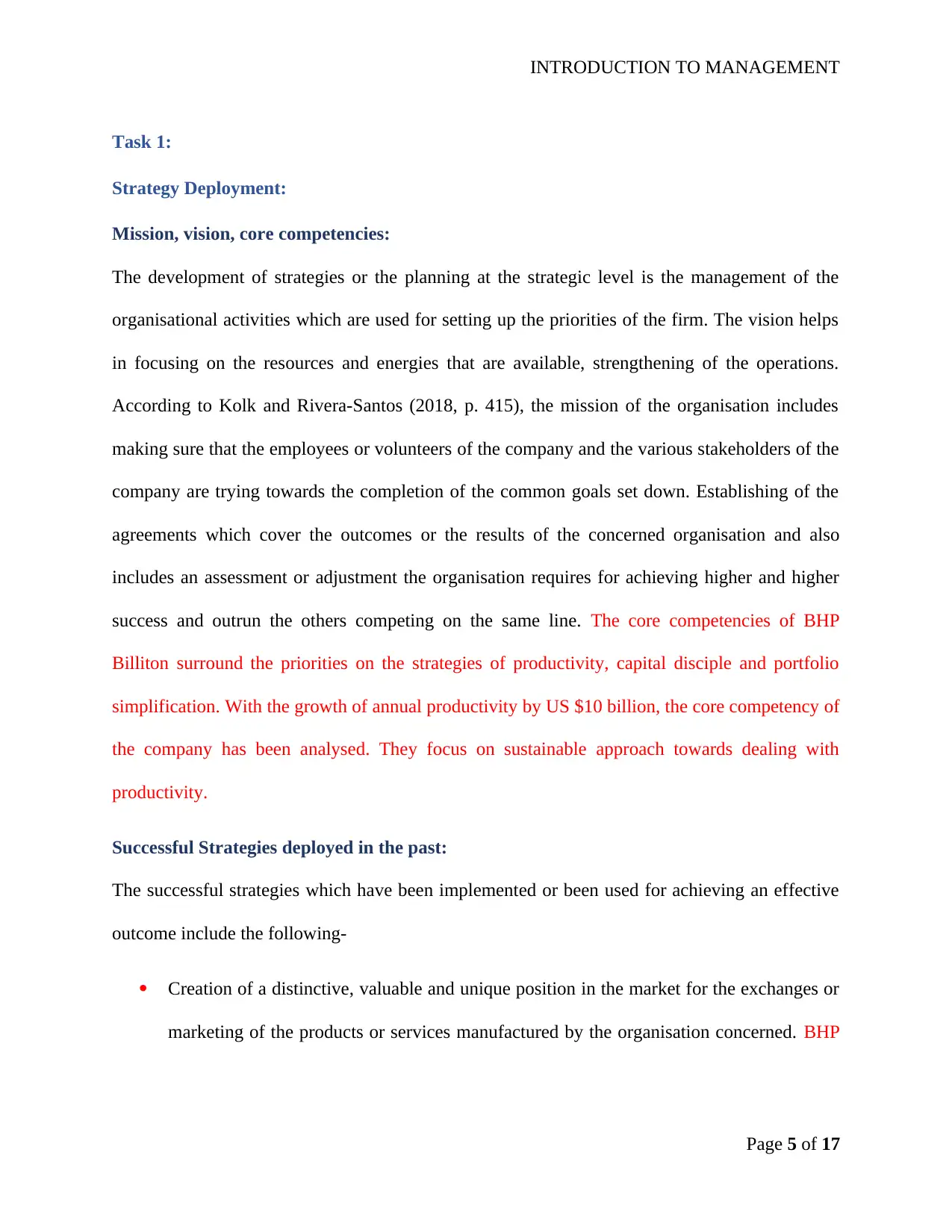
INTRODUCTION TO MANAGEMENT
Task 1:
Strategy Deployment:
Mission, vision, core competencies:
The development of strategies or the planning at the strategic level is the management of the
organisational activities which are used for setting up the priorities of the firm. The vision helps
in focusing on the resources and energies that are available, strengthening of the operations.
According to Kolk and Rivera-Santos (2018, p. 415), the mission of the organisation includes
making sure that the employees or volunteers of the company and the various stakeholders of the
company are trying towards the completion of the common goals set down. Establishing of the
agreements which cover the outcomes or the results of the concerned organisation and also
includes an assessment or adjustment the organisation requires for achieving higher and higher
success and outrun the others competing on the same line. The core competencies of BHP
Billiton surround the priorities on the strategies of productivity, capital disciple and portfolio
simplification. With the growth of annual productivity by US $10 billion, the core competency of
the company has been analysed. They focus on sustainable approach towards dealing with
productivity.
Successful Strategies deployed in the past:
The successful strategies which have been implemented or been used for achieving an effective
outcome include the following-
Creation of a distinctive, valuable and unique position in the market for the exchanges or
marketing of the products or services manufactured by the organisation concerned. BHP
Page 5 of 17
Task 1:
Strategy Deployment:
Mission, vision, core competencies:
The development of strategies or the planning at the strategic level is the management of the
organisational activities which are used for setting up the priorities of the firm. The vision helps
in focusing on the resources and energies that are available, strengthening of the operations.
According to Kolk and Rivera-Santos (2018, p. 415), the mission of the organisation includes
making sure that the employees or volunteers of the company and the various stakeholders of the
company are trying towards the completion of the common goals set down. Establishing of the
agreements which cover the outcomes or the results of the concerned organisation and also
includes an assessment or adjustment the organisation requires for achieving higher and higher
success and outrun the others competing on the same line. The core competencies of BHP
Billiton surround the priorities on the strategies of productivity, capital disciple and portfolio
simplification. With the growth of annual productivity by US $10 billion, the core competency of
the company has been analysed. They focus on sustainable approach towards dealing with
productivity.
Successful Strategies deployed in the past:
The successful strategies which have been implemented or been used for achieving an effective
outcome include the following-
Creation of a distinctive, valuable and unique position in the market for the exchanges or
marketing of the products or services manufactured by the organisation concerned. BHP
Page 5 of 17
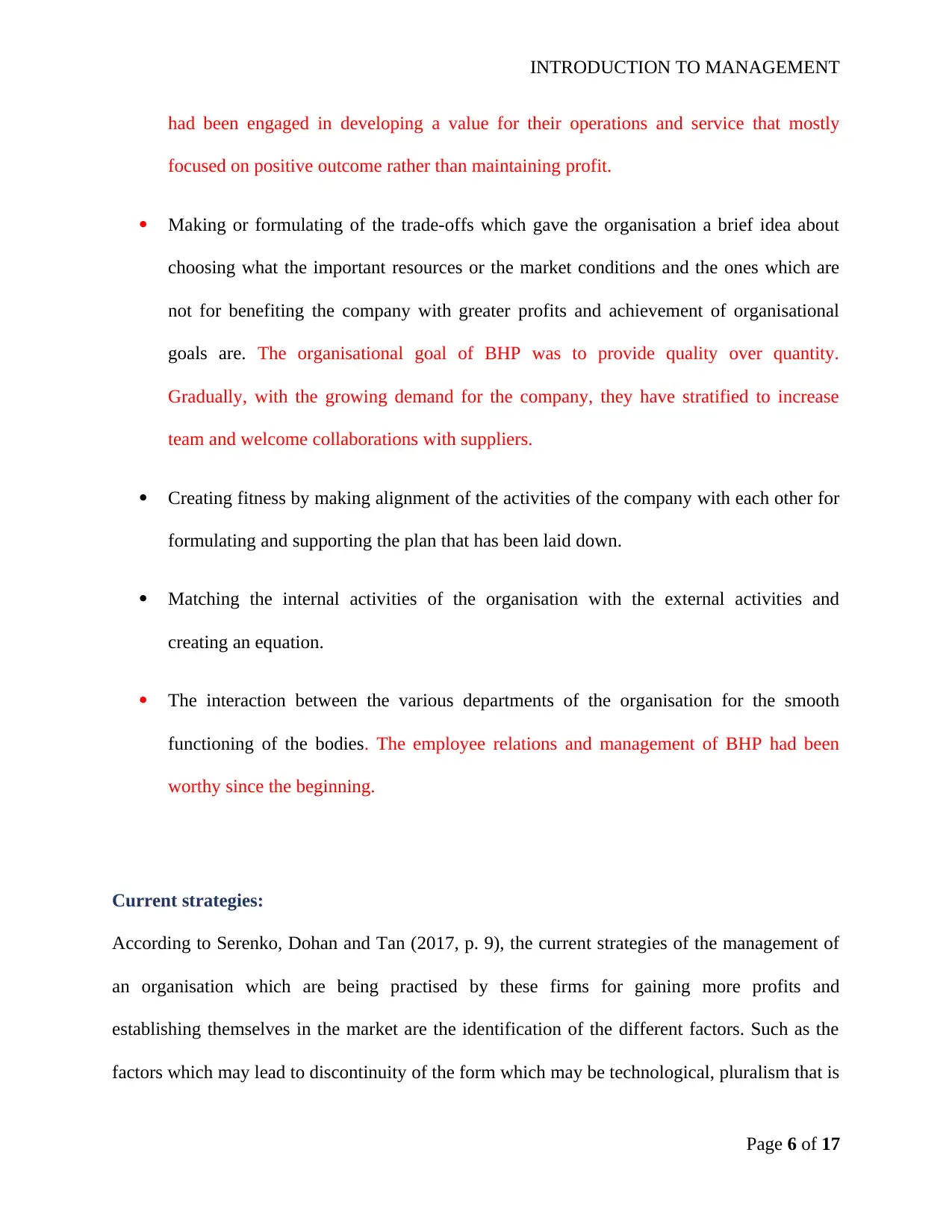
INTRODUCTION TO MANAGEMENT
had been engaged in developing a value for their operations and service that mostly
focused on positive outcome rather than maintaining profit.
Making or formulating of the trade-offs which gave the organisation a brief idea about
choosing what the important resources or the market conditions and the ones which are
not for benefiting the company with greater profits and achievement of organisational
goals are. The organisational goal of BHP was to provide quality over quantity.
Gradually, with the growing demand for the company, they have stratified to increase
team and welcome collaborations with suppliers.
Creating fitness by making alignment of the activities of the company with each other for
formulating and supporting the plan that has been laid down.
Matching the internal activities of the organisation with the external activities and
creating an equation.
The interaction between the various departments of the organisation for the smooth
functioning of the bodies. The employee relations and management of BHP had been
worthy since the beginning.
Current strategies:
According to Serenko, Dohan and Tan (2017, p. 9), the current strategies of the management of
an organisation which are being practised by these firms for gaining more profits and
establishing themselves in the market are the identification of the different factors. Such as the
factors which may lead to discontinuity of the form which may be technological, pluralism that is
Page 6 of 17
had been engaged in developing a value for their operations and service that mostly
focused on positive outcome rather than maintaining profit.
Making or formulating of the trade-offs which gave the organisation a brief idea about
choosing what the important resources or the market conditions and the ones which are
not for benefiting the company with greater profits and achievement of organisational
goals are. The organisational goal of BHP was to provide quality over quantity.
Gradually, with the growing demand for the company, they have stratified to increase
team and welcome collaborations with suppliers.
Creating fitness by making alignment of the activities of the company with each other for
formulating and supporting the plan that has been laid down.
Matching the internal activities of the organisation with the external activities and
creating an equation.
The interaction between the various departments of the organisation for the smooth
functioning of the bodies. The employee relations and management of BHP had been
worthy since the beginning.
Current strategies:
According to Serenko, Dohan and Tan (2017, p. 9), the current strategies of the management of
an organisation which are being practised by these firms for gaining more profits and
establishing themselves in the market are the identification of the different factors. Such as the
factors which may lead to discontinuity of the form which may be technological, pluralism that is
Page 6 of 17
⊘ This is a preview!⊘
Do you want full access?
Subscribe today to unlock all pages.

Trusted by 1+ million students worldwide
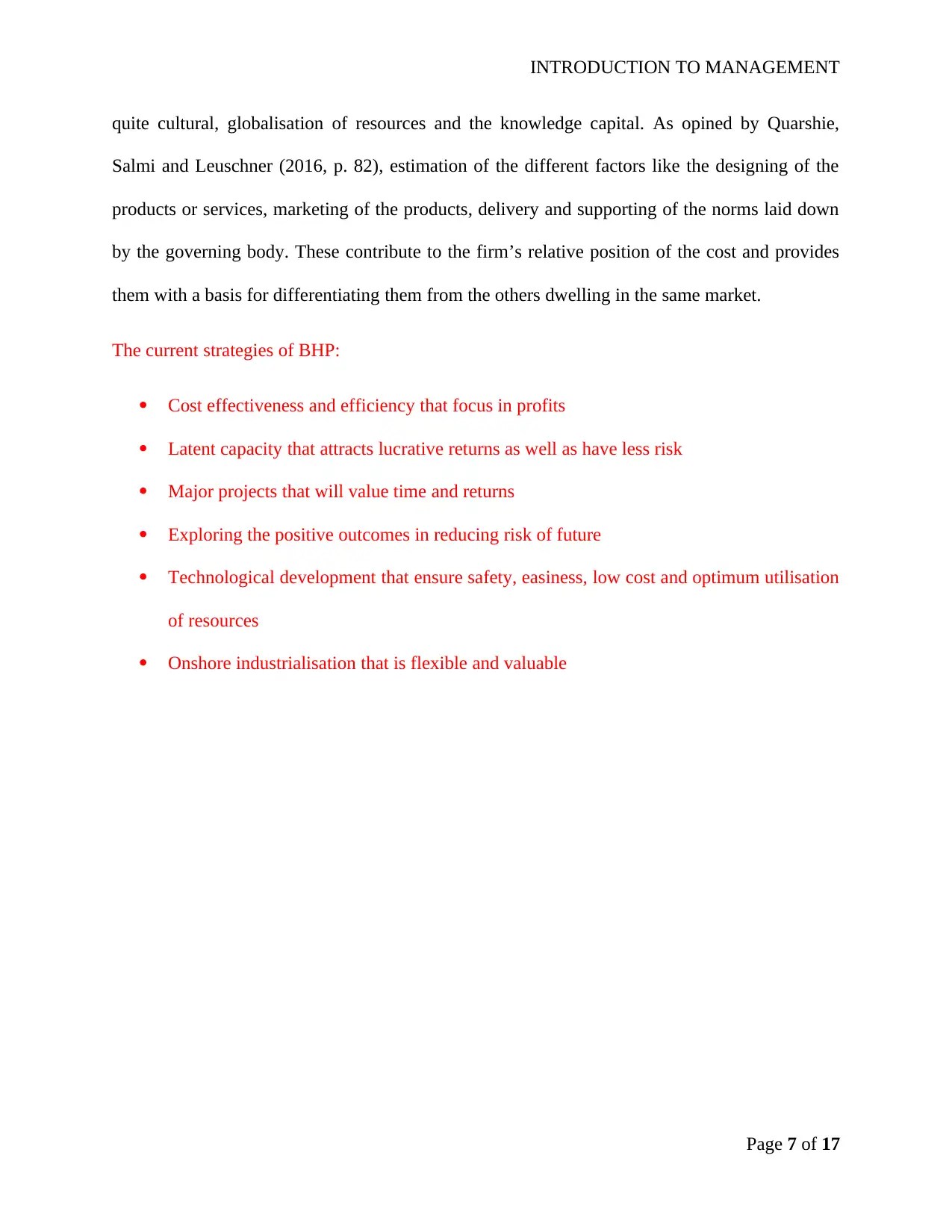
INTRODUCTION TO MANAGEMENT
quite cultural, globalisation of resources and the knowledge capital. As opined by Quarshie,
Salmi and Leuschner (2016, p. 82), estimation of the different factors like the designing of the
products or services, marketing of the products, delivery and supporting of the norms laid down
by the governing body. These contribute to the firm’s relative position of the cost and provides
them with a basis for differentiating them from the others dwelling in the same market.
The current strategies of BHP:
Cost effectiveness and efficiency that focus in profits
Latent capacity that attracts lucrative returns as well as have less risk
Major projects that will value time and returns
Exploring the positive outcomes in reducing risk of future
Technological development that ensure safety, easiness, low cost and optimum utilisation
of resources
Onshore industrialisation that is flexible and valuable
Page 7 of 17
quite cultural, globalisation of resources and the knowledge capital. As opined by Quarshie,
Salmi and Leuschner (2016, p. 82), estimation of the different factors like the designing of the
products or services, marketing of the products, delivery and supporting of the norms laid down
by the governing body. These contribute to the firm’s relative position of the cost and provides
them with a basis for differentiating them from the others dwelling in the same market.
The current strategies of BHP:
Cost effectiveness and efficiency that focus in profits
Latent capacity that attracts lucrative returns as well as have less risk
Major projects that will value time and returns
Exploring the positive outcomes in reducing risk of future
Technological development that ensure safety, easiness, low cost and optimum utilisation
of resources
Onshore industrialisation that is flexible and valuable
Page 7 of 17
Paraphrase This Document
Need a fresh take? Get an instant paraphrase of this document with our AI Paraphraser
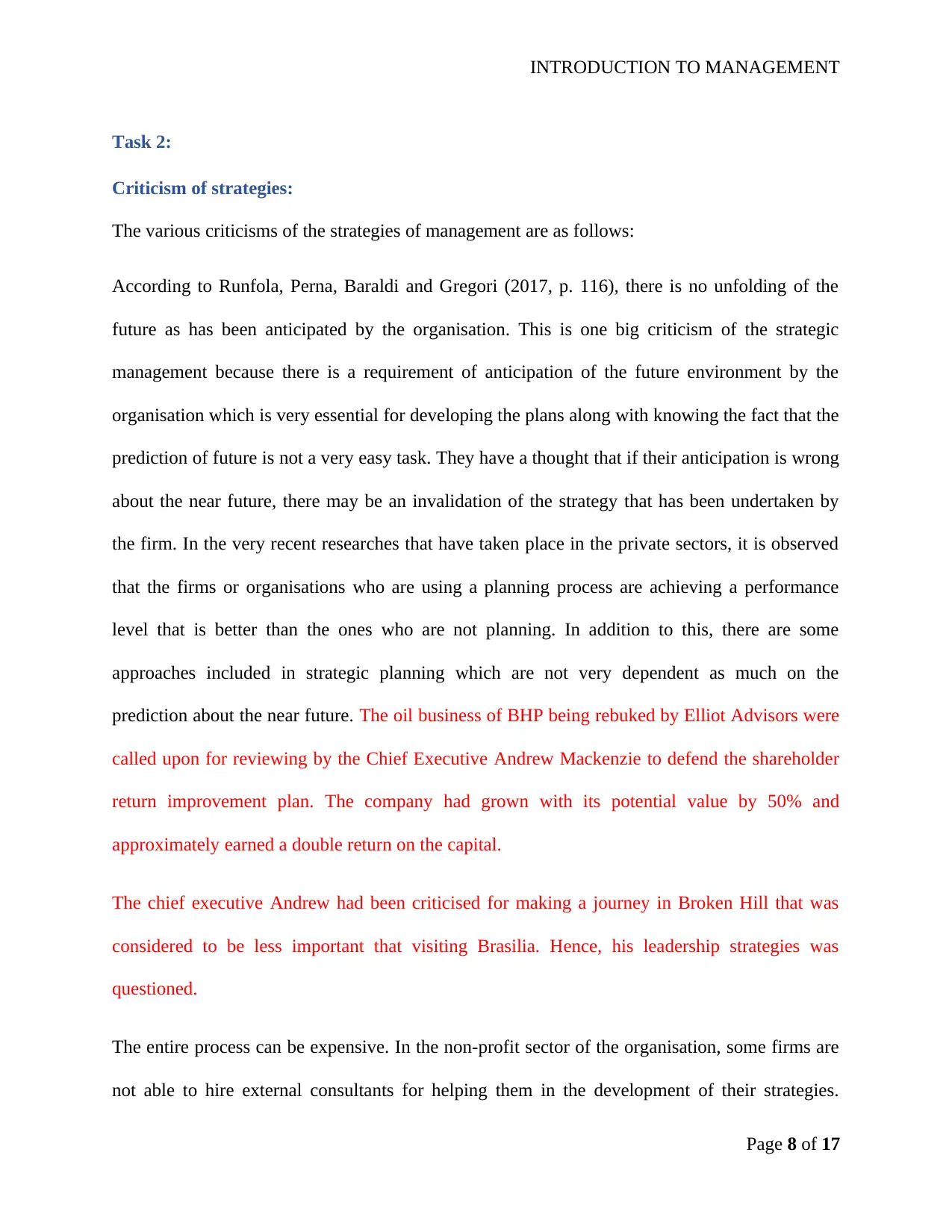
INTRODUCTION TO MANAGEMENT
Task 2:
Criticism of strategies:
The various criticisms of the strategies of management are as follows:
According to Runfola, Perna, Baraldi and Gregori (2017, p. 116), there is no unfolding of the
future as has been anticipated by the organisation. This is one big criticism of the strategic
management because there is a requirement of anticipation of the future environment by the
organisation which is very essential for developing the plans along with knowing the fact that the
prediction of future is not a very easy task. They have a thought that if their anticipation is wrong
about the near future, there may be an invalidation of the strategy that has been undertaken by
the firm. In the very recent researches that have taken place in the private sectors, it is observed
that the firms or organisations who are using a planning process are achieving a performance
level that is better than the ones who are not planning. In addition to this, there are some
approaches included in strategic planning which are not very dependent as much on the
prediction about the near future. The oil business of BHP being rebuked by Elliot Advisors were
called upon for reviewing by the Chief Executive Andrew Mackenzie to defend the shareholder
return improvement plan. The company had grown with its potential value by 50% and
approximately earned a double return on the capital.
The chief executive Andrew had been criticised for making a journey in Broken Hill that was
considered to be less important that visiting Brasilia. Hence, his leadership strategies was
questioned.
The entire process can be expensive. In the non-profit sector of the organisation, some firms are
not able to hire external consultants for helping them in the development of their strategies.
Page 8 of 17
Task 2:
Criticism of strategies:
The various criticisms of the strategies of management are as follows:
According to Runfola, Perna, Baraldi and Gregori (2017, p. 116), there is no unfolding of the
future as has been anticipated by the organisation. This is one big criticism of the strategic
management because there is a requirement of anticipation of the future environment by the
organisation which is very essential for developing the plans along with knowing the fact that the
prediction of future is not a very easy task. They have a thought that if their anticipation is wrong
about the near future, there may be an invalidation of the strategy that has been undertaken by
the firm. In the very recent researches that have taken place in the private sectors, it is observed
that the firms or organisations who are using a planning process are achieving a performance
level that is better than the ones who are not planning. In addition to this, there are some
approaches included in strategic planning which are not very dependent as much on the
prediction about the near future. The oil business of BHP being rebuked by Elliot Advisors were
called upon for reviewing by the Chief Executive Andrew Mackenzie to defend the shareholder
return improvement plan. The company had grown with its potential value by 50% and
approximately earned a double return on the capital.
The chief executive Andrew had been criticised for making a journey in Broken Hill that was
considered to be less important that visiting Brasilia. Hence, his leadership strategies was
questioned.
The entire process can be expensive. In the non-profit sector of the organisation, some firms are
not able to hire external consultants for helping them in the development of their strategies.
Page 8 of 17
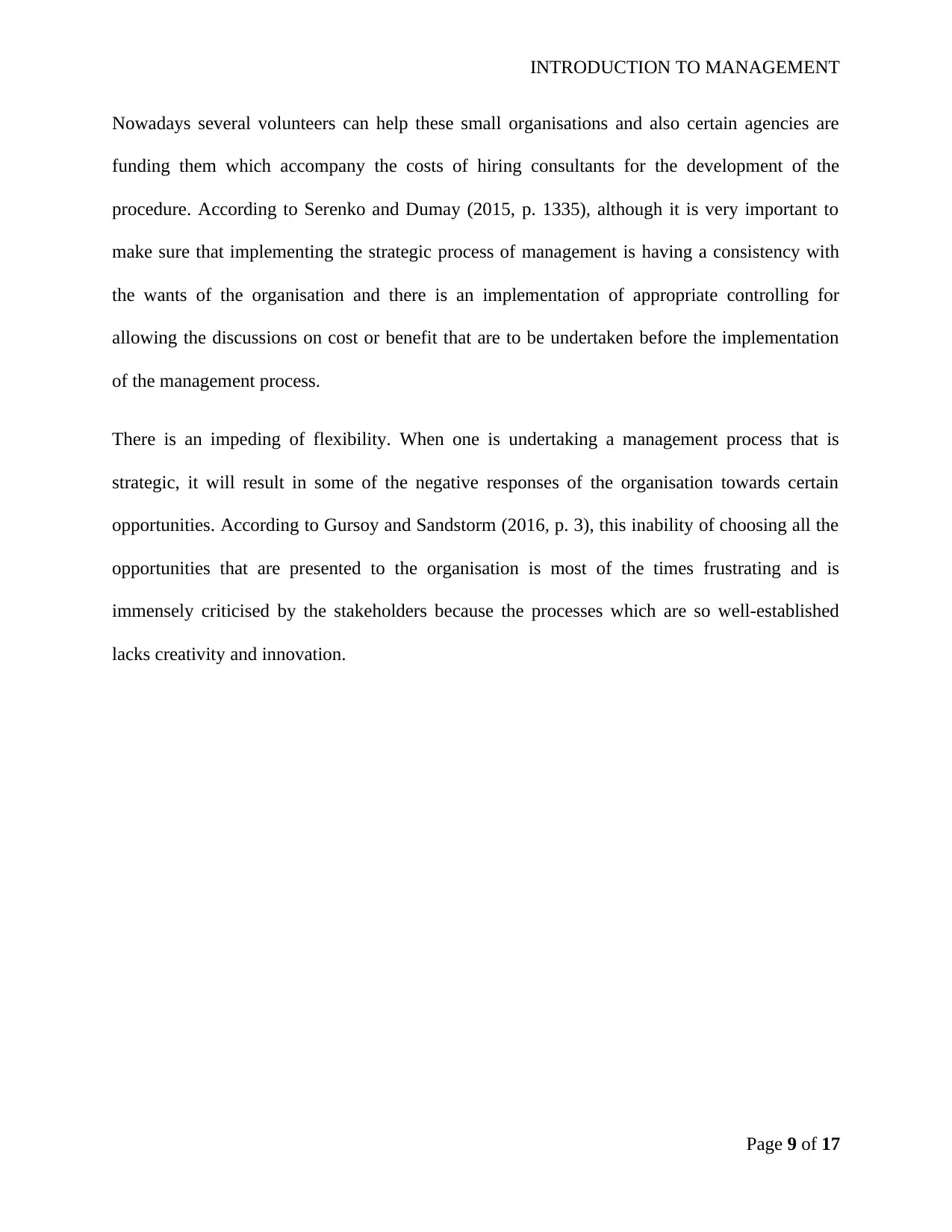
INTRODUCTION TO MANAGEMENT
Nowadays several volunteers can help these small organisations and also certain agencies are
funding them which accompany the costs of hiring consultants for the development of the
procedure. According to Serenko and Dumay (2015, p. 1335), although it is very important to
make sure that implementing the strategic process of management is having a consistency with
the wants of the organisation and there is an implementation of appropriate controlling for
allowing the discussions on cost or benefit that are to be undertaken before the implementation
of the management process.
There is an impeding of flexibility. When one is undertaking a management process that is
strategic, it will result in some of the negative responses of the organisation towards certain
opportunities. According to Gursoy and Sandstorm (2016, p. 3), this inability of choosing all the
opportunities that are presented to the organisation is most of the times frustrating and is
immensely criticised by the stakeholders because the processes which are so well-established
lacks creativity and innovation.
Page 9 of 17
Nowadays several volunteers can help these small organisations and also certain agencies are
funding them which accompany the costs of hiring consultants for the development of the
procedure. According to Serenko and Dumay (2015, p. 1335), although it is very important to
make sure that implementing the strategic process of management is having a consistency with
the wants of the organisation and there is an implementation of appropriate controlling for
allowing the discussions on cost or benefit that are to be undertaken before the implementation
of the management process.
There is an impeding of flexibility. When one is undertaking a management process that is
strategic, it will result in some of the negative responses of the organisation towards certain
opportunities. According to Gursoy and Sandstorm (2016, p. 3), this inability of choosing all the
opportunities that are presented to the organisation is most of the times frustrating and is
immensely criticised by the stakeholders because the processes which are so well-established
lacks creativity and innovation.
Page 9 of 17
⊘ This is a preview!⊘
Do you want full access?
Subscribe today to unlock all pages.

Trusted by 1+ million students worldwide
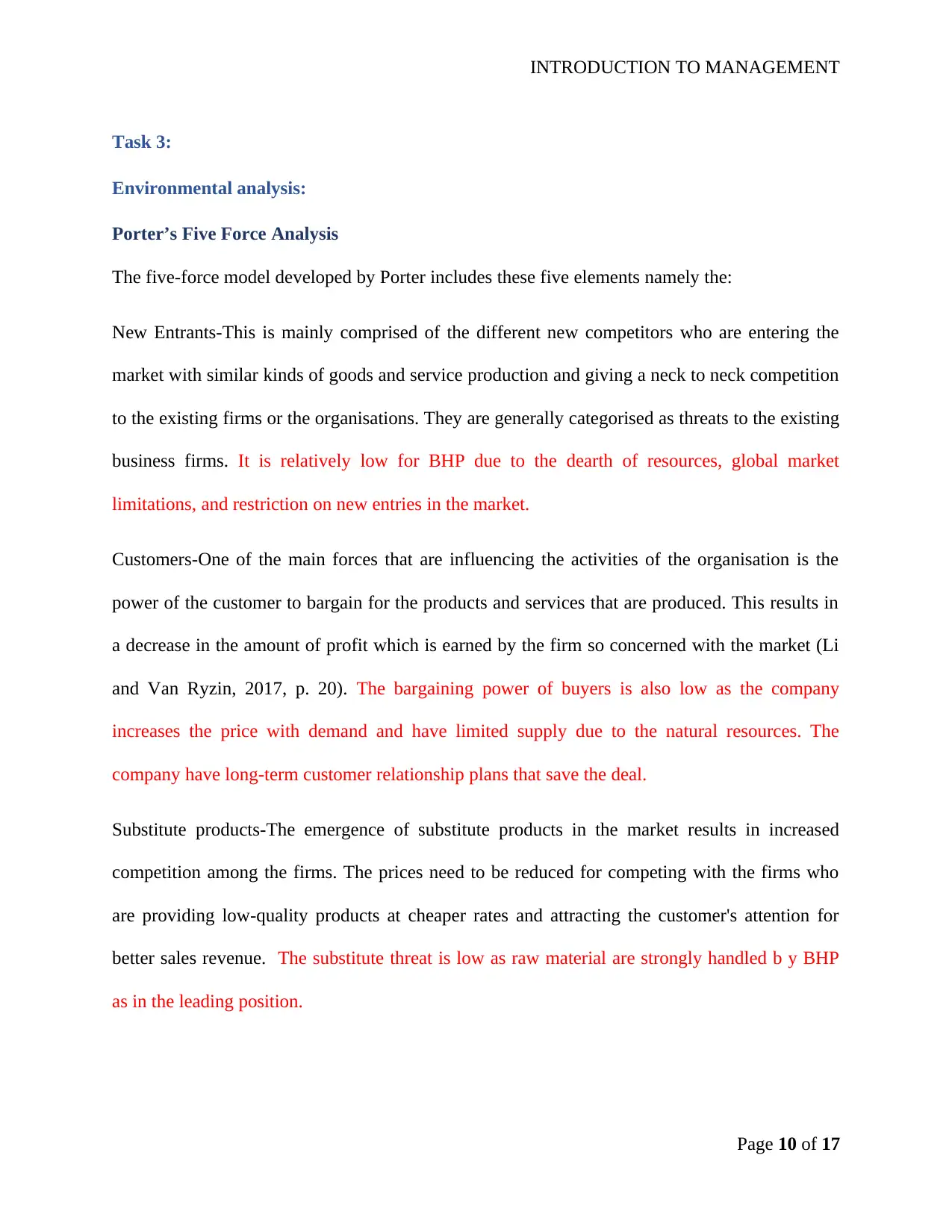
INTRODUCTION TO MANAGEMENT
Task 3:
Environmental analysis:
Porter’s Five Force Analysis
The five-force model developed by Porter includes these five elements namely the:
New Entrants-This is mainly comprised of the different new competitors who are entering the
market with similar kinds of goods and service production and giving a neck to neck competition
to the existing firms or the organisations. They are generally categorised as threats to the existing
business firms. It is relatively low for BHP due to the dearth of resources, global market
limitations, and restriction on new entries in the market.
Customers-One of the main forces that are influencing the activities of the organisation is the
power of the customer to bargain for the products and services that are produced. This results in
a decrease in the amount of profit which is earned by the firm so concerned with the market (Li
and Van Ryzin, 2017, p. 20). The bargaining power of buyers is also low as the company
increases the price with demand and have limited supply due to the natural resources. The
company have long-term customer relationship plans that save the deal.
Substitute products-The emergence of substitute products in the market results in increased
competition among the firms. The prices need to be reduced for competing with the firms who
are providing low-quality products at cheaper rates and attracting the customer's attention for
better sales revenue. The substitute threat is low as raw material are strongly handled b y BHP
as in the leading position.
Page 10 of 17
Task 3:
Environmental analysis:
Porter’s Five Force Analysis
The five-force model developed by Porter includes these five elements namely the:
New Entrants-This is mainly comprised of the different new competitors who are entering the
market with similar kinds of goods and service production and giving a neck to neck competition
to the existing firms or the organisations. They are generally categorised as threats to the existing
business firms. It is relatively low for BHP due to the dearth of resources, global market
limitations, and restriction on new entries in the market.
Customers-One of the main forces that are influencing the activities of the organisation is the
power of the customer to bargain for the products and services that are produced. This results in
a decrease in the amount of profit which is earned by the firm so concerned with the market (Li
and Van Ryzin, 2017, p. 20). The bargaining power of buyers is also low as the company
increases the price with demand and have limited supply due to the natural resources. The
company have long-term customer relationship plans that save the deal.
Substitute products-The emergence of substitute products in the market results in increased
competition among the firms. The prices need to be reduced for competing with the firms who
are providing low-quality products at cheaper rates and attracting the customer's attention for
better sales revenue. The substitute threat is low as raw material are strongly handled b y BHP
as in the leading position.
Page 10 of 17
Paraphrase This Document
Need a fresh take? Get an instant paraphrase of this document with our AI Paraphraser
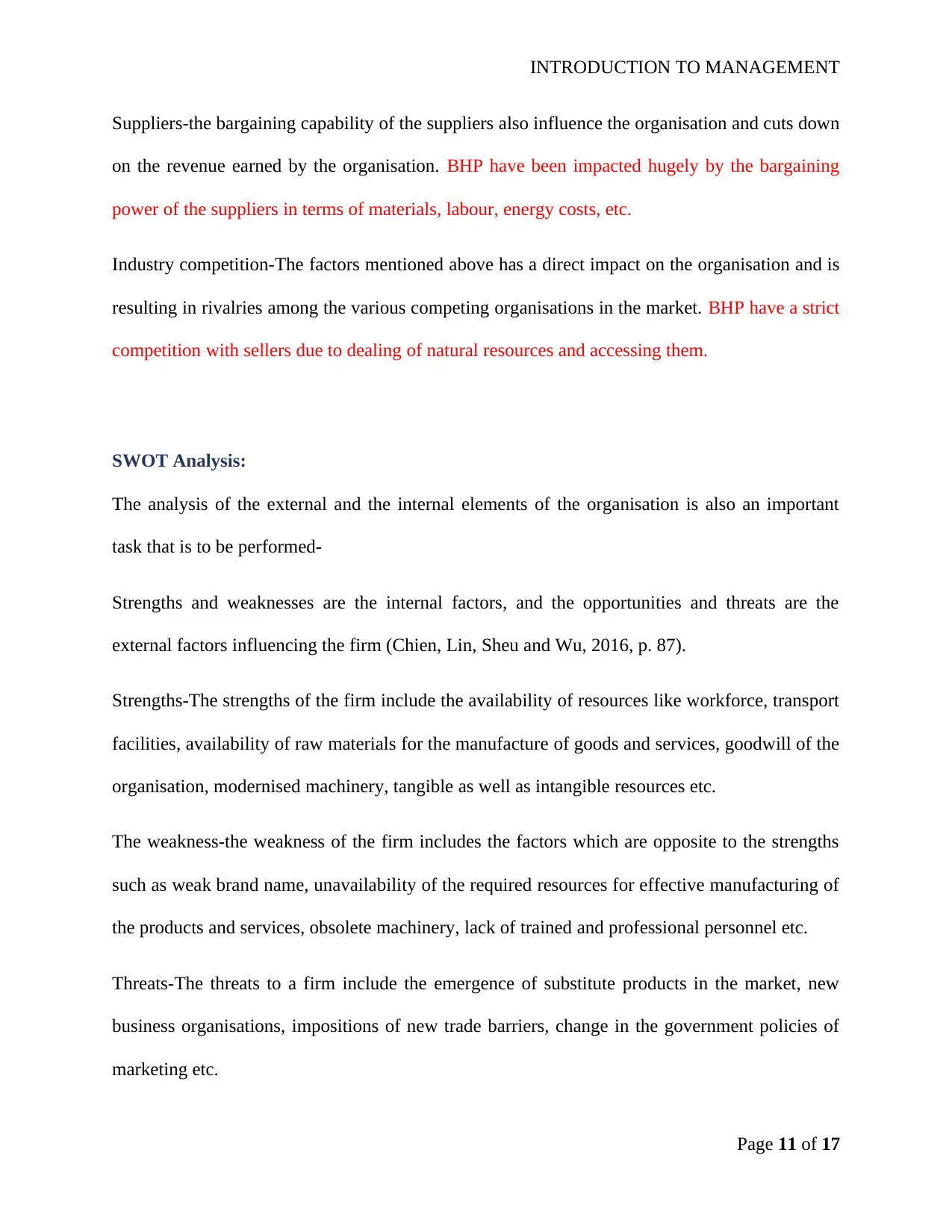
INTRODUCTION TO MANAGEMENT
Suppliers-the bargaining capability of the suppliers also influence the organisation and cuts down
on the revenue earned by the organisation. BHP have been impacted hugely by the bargaining
power of the suppliers in terms of materials, labour, energy costs, etc.
Industry competition-The factors mentioned above has a direct impact on the organisation and is
resulting in rivalries among the various competing organisations in the market. BHP have a strict
competition with sellers due to dealing of natural resources and accessing them.
SWOT Analysis:
The analysis of the external and the internal elements of the organisation is also an important
task that is to be performed-
Strengths and weaknesses are the internal factors, and the opportunities and threats are the
external factors influencing the firm (Chien, Lin, Sheu and Wu, 2016, p. 87).
Strengths-The strengths of the firm include the availability of resources like workforce, transport
facilities, availability of raw materials for the manufacture of goods and services, goodwill of the
organisation, modernised machinery, tangible as well as intangible resources etc.
The weakness-the weakness of the firm includes the factors which are opposite to the strengths
such as weak brand name, unavailability of the required resources for effective manufacturing of
the products and services, obsolete machinery, lack of trained and professional personnel etc.
Threats-The threats to a firm include the emergence of substitute products in the market, new
business organisations, impositions of new trade barriers, change in the government policies of
marketing etc.
Page 11 of 17
Suppliers-the bargaining capability of the suppliers also influence the organisation and cuts down
on the revenue earned by the organisation. BHP have been impacted hugely by the bargaining
power of the suppliers in terms of materials, labour, energy costs, etc.
Industry competition-The factors mentioned above has a direct impact on the organisation and is
resulting in rivalries among the various competing organisations in the market. BHP have a strict
competition with sellers due to dealing of natural resources and accessing them.
SWOT Analysis:
The analysis of the external and the internal elements of the organisation is also an important
task that is to be performed-
Strengths and weaknesses are the internal factors, and the opportunities and threats are the
external factors influencing the firm (Chien, Lin, Sheu and Wu, 2016, p. 87).
Strengths-The strengths of the firm include the availability of resources like workforce, transport
facilities, availability of raw materials for the manufacture of goods and services, goodwill of the
organisation, modernised machinery, tangible as well as intangible resources etc.
The weakness-the weakness of the firm includes the factors which are opposite to the strengths
such as weak brand name, unavailability of the required resources for effective manufacturing of
the products and services, obsolete machinery, lack of trained and professional personnel etc.
Threats-The threats to a firm include the emergence of substitute products in the market, new
business organisations, impositions of new trade barriers, change in the government policies of
marketing etc.
Page 11 of 17
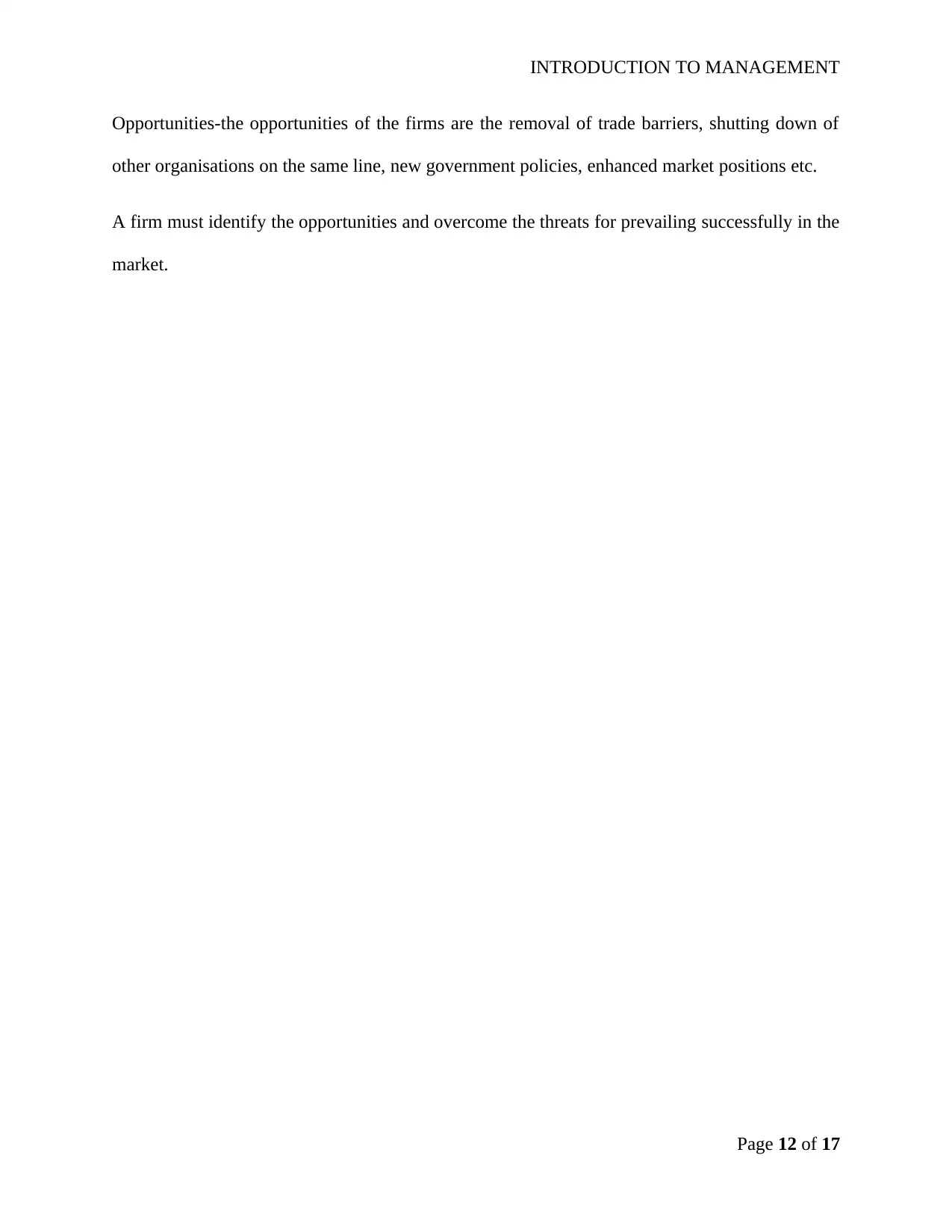
INTRODUCTION TO MANAGEMENT
Opportunities-the opportunities of the firms are the removal of trade barriers, shutting down of
other organisations on the same line, new government policies, enhanced market positions etc.
A firm must identify the opportunities and overcome the threats for prevailing successfully in the
market.
Page 12 of 17
Opportunities-the opportunities of the firms are the removal of trade barriers, shutting down of
other organisations on the same line, new government policies, enhanced market positions etc.
A firm must identify the opportunities and overcome the threats for prevailing successfully in the
market.
Page 12 of 17
⊘ This is a preview!⊘
Do you want full access?
Subscribe today to unlock all pages.

Trusted by 1+ million students worldwide
1 out of 17
Related Documents
Your All-in-One AI-Powered Toolkit for Academic Success.
+13062052269
info@desklib.com
Available 24*7 on WhatsApp / Email
![[object Object]](/_next/static/media/star-bottom.7253800d.svg)
Unlock your academic potential
Copyright © 2020–2025 A2Z Services. All Rights Reserved. Developed and managed by ZUCOL.




